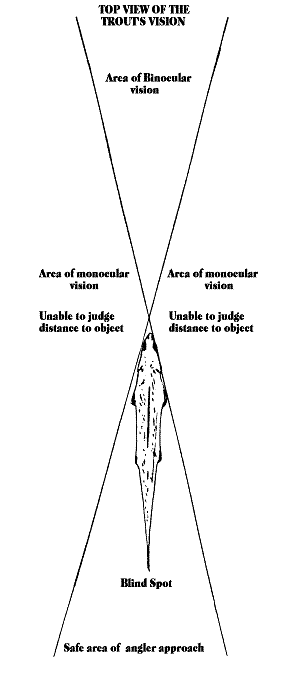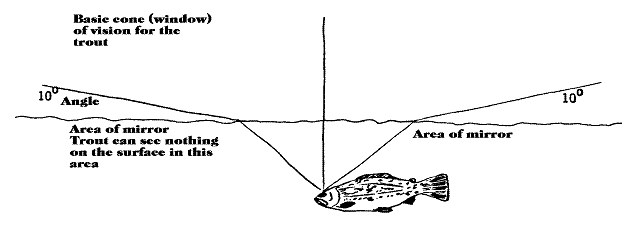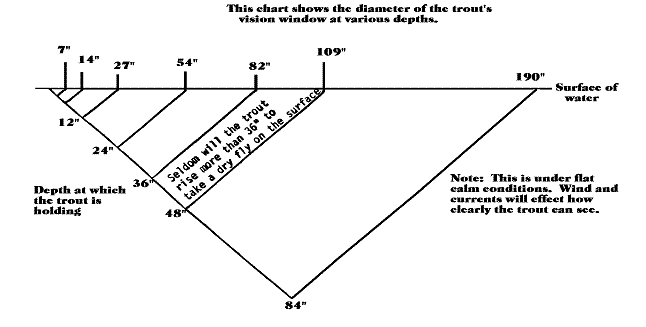PALE MORNING DUNS (part 5)
| Sysadmin Note |
|---|
Click here for Part 4. This is Part 5 in the series |
WHAT TROUT SEE
Figures #1, #2 & #3 show the trout's basic cone (field) of vision and what the trout can see while holding deep versus what the trout can see when holding close to the surface.
 Figure #1
Figure #1
 Figure #2
Figure #2
 Figure #3
Figure #3
Now that we have a basic understanding of how the trout sees, we will explore what the trout sees as a mayfly enters its field of vision and how the information relates to pattern selection and presentation. The angler should remember that the artificial is nothing more than an imitation of the natural. Therefore if we want the trout to see the imitation as he does the natural we must strive to match that imitation as close as possible. Some say that because of the refracted light the trout doesn't see this or that, but it is the entire fly which lends color to all parts therefore the artificial must be complete if we wish it to appear as the natural. The optical facts, which govern the manner in which a trout sees things on the surface, are well known physical laws concerning how light rays are bent or refracted when entering the water.
In A Modern Dry Fly Code, Vince Marinaro gives what I consider to be the best explanation of the trout's field of view or "window" and how it is affected by the physical laws of refraction. Therefore, for those who would like a detailed and in depth study on this subject I highly recommend that you read this book. Understanding how the trout sees will be very important for the serious angler to master. The study of light patterns, refraction and the trout's window can indeed prove to be heady material and is not for everyone.
Now we will move on and talk about the different types of hatches the angler may encounter and how to solve the problems these hatches can present. The easiest hatch for the angler is the simple hatch. This is where a single species of mayfly is hatching. If the trout are feeding on the surface, all the angler needs to do is make the proper approach, select the pattern that closely imitates the natural and make a proper drag free presentation. I can hear some anglers now saying "This is easy!! Ha!" Sure, this is the easy one. Wait and see.
The next hatch that the angler may encounter is the compound masking hatch. This situation can be encountered on several area streams such as the Henry's Fork, Upper Yellowstone (above the Falls), Firehole, Slough Creek (below the campground) and Missouri River (below Holter Dam) just to name a few. To better explain this particular phenomenon I will relate one of my experiences on the South Branch of the Au Sable River (Michigan). This incident first made me aware of compound masking hatches.
The Hendricksons were on the water and the trout were moving to the duns in a regular feeding rhythm. I had been enjoying success with a size 14 Hendrickson thorax style dun, until I came to a long, smooth section lined with cedar sweeps. This section had some very nice trout (12" to 15") feeding tight along the banks. I worked those bank feeders for the better part of 40 minutes to no avail. They were just not interested in the Hendrickson imitations.
After they had, well let's just say, slowed down the feeding rhythm, I waded over into their drift line to take a look. The reason they were not interested in the Hendrickson was that there was a heavier hatch of size 16 Paraleptophlebia species on the water. I backed out, and sat down to rest the spot. In about 15 or 20 minutes the trout resumed their feeding. I had changed flies putting on a size 16 thorax dun and it worked, sort of. Oh the trout took it readily enough. It's just that I was tad bit excited over solving this problem and broke the fish off on the strike. Now I'm sure nothing like this has ever happened to you. If I would have landed that fish I would have pumped the stomach to confirm my findings. As it was I had to wait until fish number four to obtain that confirmation.
The key to solving the riddle was observation. The larger, more noticeable Hendrickson was masking the hatch of the smaller flies. This is very common and anglers who are not observant are frustrated and often times fishless.
The next hatch that we will cover is the multi-masking compound complex hatch. This hatch will test your skill levels and your abilities to remain cool and calm. This is where there are several different sizes and species of insects on the water. I remember a day on Henry's Fork a few years ago where I encountered this situation. I found green drake spinners, green drake duns, pale morning duns, blue winged olive spinners and brown drakes. This doesn't even count the beetles, ants and caddis. As you might imagine, with all this food the trout were feeding like crazy, but on what?
When you encounter this situation you must be very, very observant, pick a fish, and try to figure out what that fish is taking. "How?" OK, this situation is never easy and you'll never be 100% right with every feeding trout, but there are some steps that you can follow in trying to figure out what your target is doing.
1. Pick a trout and work that trout. If you move to a second fish remember that there is a strong chance that this fish will be doing something different. In other words treat each feeding trout as an individual.
2. Approach your target as close as you can without spooking the trout. I prefer to approach from downstream. Get below the line of drift and see what insects are coming over the fish by using a small insect net to sample the water. Also determine what insect is present in the largest numbers and is easiest for the trout to capture.
3. I will also use a small pair (pocket size) of binoculars to watch the rise form and to see if I can see what the trout is eating.
4. I will then select the 3 or 4 patterns that I think might fool the trout. After considering the trout's position, the drift line, and feeding rhythm I will start casting to trout using what I believe to be the proper presentation for the situation at hand. The angler should get as close as possible, as the longer the cast the more chance there is for drag.
5. Don't waste a lot of time on a pattern, but at the same time don't be hasty. Remember your fly is in direct competition with lots of naturals, therefore you need to have the patience to give the trout several good drifts. But don't be afraid to change flies or tippet. If you have a hard time with knots, then you need to practice, practice and practice some more until it's no longer a problem.
6. If you feel that you are doing everything in the proper manner but you still haven't moved the fish then you may want to choose another fish and start the process over.
This type of hatch is a very interesting and technical problem for the serious angler, but one that has its own rewards when you are successful.
I am often asked "What if no hatch is in progress? What patterns would you use as searching flies and does this method work on rivers where the trout are hatch oriented?"
Sure you can use searching patterns and methods but they have to be attuned to the stream you are fishing. Let me explain.
As an example I will use DePuy's Spring Creek during late July. On a typical day these are the patterns I would employ as searching patterns to cover the water looking for feeders of opportunity if there was no noticeable hatch or surface feeding activity.
Morning
Olive Spinner 16-18
Mid-Morning
PMD Paradun 16-18
Noon
PMD Sparkle Dun 18-20
Mid-Afternoon
PMD Comparadun 18-20
Late Afternoon
Sulfur Parachute 18-20
Evening
Sulfur Thorax 20-22
Late Evening
Olive or Sulfur Spinner 18-22
This selection of patterns is geared toward imitating naturals that the trout would be seeing during this time period and the pattern selection would change as the hatches change and of course would vary from river to river depending on the hatches.
The angler who has good basic casting and presentation skills, is observant, approaches with caution, has a good understanding of the trout and its habits and carries the most complete selection of imitations possible for the area being fished, will generally be able to find something the trout will be interested in. But all factors must be studied and evaluated if the angler wishes to consistently take selective trout.
This information is by no means the final word on strategies. I strongly urge the angler to read and study other methods to gain a more complete understanding. Then I urge you to develop your own theories based on experience and observation. We can never learn enough and therein lays the eternal challenge and intrigue of fishing with the dry fly. Someone once said that "the inquiring mind is the progressive, learning mind". Therefore, as anglers we should all strive to be inquiring.
| Sys Admin's Note |
|---|
| Click here for Part 6 |
